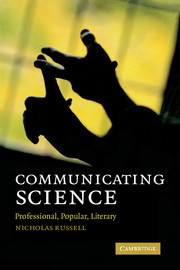Book contents
- Frontmatter
- Contents
- Introduction: What this book is about and why you might want to read it
- Prologue: Three orphans share a common paternity: professional science communication, popular journalism and literary fiction are not as separate as they seem
- Part I Professional science communication
- 1 Spreading the word: problems with publishing professional science
- 2 Walk like an Egyptian: the alien feeling of professional science writing
- 3 The future's bright? Professional science communication in the age of the internet
- 4 Counting the horse's teeth: professional standards in science's barter economy
- 5 Separating the wheat from the chaff: peer review on trial
- Part II Science for the public: what science do people need and how might they get it?
- Part III Popular science communication: the press and broadcasting
- Part IV The origins of science in cultural context: five historic dramas
- Part V Science in literature
- Index
- References
4 - Counting the horse's teeth: professional standards in science's barter economy
Published online by Cambridge University Press: 02 December 2010
- Frontmatter
- Contents
- Introduction: What this book is about and why you might want to read it
- Prologue: Three orphans share a common paternity: professional science communication, popular journalism and literary fiction are not as separate as they seem
- Part I Professional science communication
- 1 Spreading the word: problems with publishing professional science
- 2 Walk like an Egyptian: the alien feeling of professional science writing
- 3 The future's bright? Professional science communication in the age of the internet
- 4 Counting the horse's teeth: professional standards in science's barter economy
- 5 Separating the wheat from the chaff: peer review on trial
- Part II Science for the public: what science do people need and how might they get it?
- Part III Popular science communication: the press and broadcasting
- Part IV The origins of science in cultural context: five historic dramas
- Part V Science in literature
- Index
- References
Summary
Karl Sabbagh tells the unhappy story of Professor J.W. Heslop Harrison FRS and his lapses from the professional standards of behaviour expected of a scientist. He came from humble beginnings, the son of an iron worker, and grew up in harsh conditions in the early part of the twentieth century. By dint of hard work he went to university and eventually became an academic botanist, specializing in the study of plant classification and distribution. In the 1930s when Heslop Harrison began his professional career, the Hebridean islands off the Scottish coast were largely unexplored. When he and others made scientific surveys on the islands, they discovered they had unique species and subspecies of plant and insect, some of which were new to science. These discoveries made Heslop Harrison's reputation. His richest site was the island of Rum, previously in private hands and not botanically examined at all.
At first, his discoveries attracted no suspicion. But by the end of the 1930s some of his claims were becoming bizarre. He was using them to support a hypothesis that the islands had escaped the last Ice Age which had buried the Scottish mainland under a massive sheet of ice. The final straw for a Cambridge colleague, John Raven (a classicist and amateur naturalist), came in 1941 when Heslop Harrison published two papers announcing the discovery on Rum of species previously unknown in Great Britain. After the war, Raven managed to join one of Heslop Harrison's expeditions to the island and see these wonders for himself. […]
- Type
- Chapter
- Information
- Communicating ScienceProfessional, Popular, Literary, pp. 40 - 52Publisher: Cambridge University PressPrint publication year: 2009
References
- 1
- Cited by



